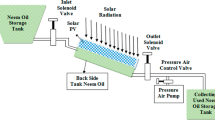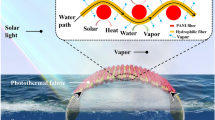Abstract
The very high heat flux dissipated by a Central Processing Unit (CPU) can no longer be handled by a conventional, single-phased cooling system. Thermal management of a CPU is now moving towards two-phase systems to maintain CPUs below their maximum temperature. A heat pipe is one of the emerging cooling systems to address this issue because of its superior efficiency and energy input independence. The goal of this research is to improve the performance of a heat pipe by integrating a biomaterial as the wick structure. In this work, the heat pipe was made from copper pipe and the biomaterial wick structure was made from tabulate coral with a mean pore diameter of 52.95 μm. For comparison purposes, the wick structure was fabricated from sintered Cu-powder with a mean pore diameter of 58.57 µm. The working fluid for this experiment was water. The experiment was conducted using a processor as the heat source and a plate simulator to measure the heat flux. The utilization of coral as the wick structure can improve the performance of a heat pipe and can decrease the temperature of a simulator plate by as much as 38.6 % at the maximum heat load compared to a conventional copper heat sink. This method also decreased the temperature of the simulator plate by as much as 44.25 °C compared to a heat pipe composed of a sintered Cu-powder wick.















Similar content being viewed by others
References
Chein R, Huang G (2004) Thermoelectric cooler application in electronic cooling. Appl Therm Eng 24:2207–2217
Mihai IC (2009) Heat transfer in minichannels and microchannels CPU cooling systems. In: Advanced topics in optoelectronics, microelectronics, and nanotechnologies IV, pp 72971N-72971N-5
Solomon AB, Ramachandran K, Pillai BC (2012) Thermal performance of a heat pipe with nanoparticles coated wick. Appl Therm Eng 36:106–112
Amon CH, Murthy J, Yao S, Narumanchi S, Wu C-F, Hsieh C-C (2001) MEMS-enabled thermal management of high-heat-flux devices EDIFICE: embedded droplet impingement for integrated cooling of electronics. Exp Therm Fluid Sci 25:231–242
Mudawar I (2001) Assessment of high-heat-flux thermal management schemes. IEEE Trans Compon Packag Technol 24:122–141
Kaya T, Goldak J (2006) Numerical analysis of heat and mass transfer in the capillary structure of a loop heat pipe. Int J Heat Mass Transf 49:3211–3220
Lips S, Lefèvre F, Bonjour J (2009) Nucleate boiling in a flat grooved heat pipe. Int J Therm Sci 48:1273–1278
Vasiliev LL (2005) Heat pipes in modern heat exchangers. Appl Therm Eng 25:1–19
Putra N, Septiadi WN, Rahman H, Irwansyah R (2012) Thermal performance of screen mesh wick heat pipes with nanofluids. Exp Therm Fluid Sci 40:10–17
Espinosa FAD, Peters JGBTB (2012) Effect of fabrication parameters on the thermophysical properties of sintered wicks for heat pipe applications. Int J Heat Mass Transf 55:7471–7486
Reay D, Kew P (2006) Heat pipe: theory, design and applications. Elsevier, London
Weibel JA, Garimella SV, North MT (2010) Characterization of evaporation and boiling from sintered powder wicks fed by capillary action. Int J Heat Mass Transf 53:4204–4215
Harris JR (2008) Modeling, designing, fabricating, and testing of channel panel flat plate heat pipes. Logan, Masters thesis
Li J, Zou Y, Cheng L (2010) Experimental study on capillary pumping performance of porous wicks for loop heat pipe. Exp Therm Fluid Sci 34:1403–1408
Deng D, Liang D, Tang Y, Peng J, Han X, Pan M (2013) Evaluation of capillary performance of sintered porous wicks for loop heat pipe. Exp Therm Fluid Sci 50:1–9
Shirazy MRS, Blais S, Fréchette LG (2012) Mechanism of wettability transition in copper metal foams: from superhydrophilic to hydrophobic. Appl Surf Sci 258:6416–6424
Putra N, Septiadi WN, Irwansyah R (2013) Effect of concentration and loading fluid of nanofluids on the thermal resistance of sintered powder wick heat pipe. Adv Mater Res 651:728–735
Putra N, Saleh R, Septiadi WN, Okta A, Hamid Z (2014) Thermal performance of biomaterial wick loop heat pipes with water-base Al2O3 nanofluids. Int J Therm Sci 76:128–136
Putra N, Septiadi WN, Saleh R, Koestoer RA (2014) The eefect of CuO–water nonofluid and biomaterial wick on loof heat pipe performance. Adv Mater Res 875–877:356–361
Septiadi WN, Putra N, Juarsa M, Putra IPA, Sahmura R (2013) Characteristics of screen mesh wick heat pipe with nano-fluid as passive cooling system. Atom Indonesia 39:24–31
Kempers R, Robinson AJ, Ewing D, Ching CY (2008) Characterization of evaporator and condenser thermal resistances of a screen mesh wicked heat pipe. Int J Heat Mass Transf 51:6039–6046
Karakteristik Biologi Karang YTKI (Terangi) Ed., ed. Jakarta: Makalah Training Course, 2003
Leong K, Liu C, Lu G (1997) Characterization of sintered copper wicks used in heat pipes. J Porous Mater 4:303–308
Mishra DK, Saravanan TT, Khanra GP, Girikumar S, Sharma SC, Sreekumar K et al (2010) Studies on the processing of nickel base porous wicks for capillary pumped loop for thermal management of spacecrafts. Adv Powder Technol 21:658–662
Tang Y, Deng D, Lu L, Pan M, Wang Q (2010) Experimental investigation on capillary force of composite wick structure by IR thermal imaging camera. Exp Therm Fluid Sci 34:190–196
Shirazy MRS, Fréchette LG (2013) Capillary and wetting properties of copper metal foams in the presence of evaporation and sintered walls. Int J Heat Mass Transf 58:282–291
Bodla KK, Murthy JY, Garimella SV (2013) Evaporation analysis in sintered wick microstructures. Int J Heat Mass Transf 61:729–741
Wong S-C, Chen C-W (2012) Visualization and evaporator resistance measurement for a groove-wicked flat-plate heat pipe. Int J Heat Mass Transf 55:2229–2234
Canti G, Celata GP, Cumo M, Furrer M (1998) Thermal hydrolic characterization of stainless steel wicks for heat pipe applications. Revue Générale de Thermique 37:5–16
Weibel JA, Garimella SV (2012) Visualization of vapor formation regimes during capillary-fed boiling in sintered-powder heat pipe wicks. Int J Heat Mass Transf 55:3498–3510
Ren C (2011) Parametric effects on heat transfer in loop heat pipe’s wick. Int J Heat Mass Transf 54:3987–3999
Holley B, Faghri A (2006) Permeability and effective pore radius measurements for heat pipe and fuel cell applications. Appl Therm Eng 26:448–462
Lago M, Araujo M (2011) Capillary rise in porous media. J Colloid Interface Sci 234:35–43
Ahmed YMZ, Riad MI, Sayed AS, Ahlam MK, Shalabi MEH (2007) Correlation between factors controlling preparation of porous copper via sintering technique using experimental design. Powder Technol 175:48–54
Semenic T, Lin YY, Catton I, Sarraf DB (2008) Use of biporous wicks to remove high heat fluxes. Appl Therm Eng 28:278–283
Kaya T (2009) Analysis of vapor–gas bubbles in a single artery heat pipe. Int J Heat Mass Transf 52:5731–5739
Yeh C-C, Chen C-N, Chen Y-M (2009) Heat transfer analysis of a loop heat pipe with biporous wicks. Int J Heat Mass Transf 52:4426–4434
Kiseev VM, Vlassov VV, Muraoka I (2010) Experimental optimization of capillary structures for loop heat pipes and heat switches. Appl Therm Eng 30:1312–1319
Hung YM (2011) Effects of geometric design on thermal performance of star-groove micro-heat pipes. Int J Heat Mass Transf 54:1198–1209
Gurses AC, Cannistraro C, Tezcan L (1991) The inclination effect on the performance of water-filled heat pipes. Renew Energy 1:667–674
Oliver DR, Atherinost TE (1968) Mass transfer to liquid films on an inclined plane. Chem Eng Sci 23:525–536
Sadeghinezhad E, Mehrali M, Rosen MA, Akhiani AR, Latibari ST, Mehrali M, Metselaar HSC (2016) Experimental investigation of the effect of graphene nanofluids on heat pipe thermal performance. Appl Therm Eng 100:775–787
Acknowledgments
The authors would like to thank the DRPM University of Indonesia for funding this research.
Author information
Authors and Affiliations
Corresponding author
Rights and permissions
About this article
Cite this article
Putra, N., Septiadi, W.N. Improvement of heat pipe performance through integration of a coral biomaterial wick structure into the heat pipe of a CPU cooling system. Heat Mass Transfer 53, 1163–1174 (2017). https://doi.org/10.1007/s00231-016-1890-6
Received:
Accepted:
Published:
Issue Date:
DOI: https://doi.org/10.1007/s00231-016-1890-6




